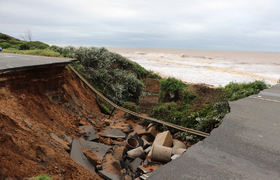How the world’s smallest flightless bird got to Inaccessible Island
02 November 2018 | Story Lisa Boonzaier. Photo Peter Ryan. Read time 9 min.
The story of the world’s smallest flightless bird alive today begins on an inhospitable, isolated island in the middle of the southern Atlantic Ocean, aptly named Inaccessible Island. More than 2 500 kilometres from any mainland, the tiny Inaccessible Island is uninhabited by people and mostly uninhabited by animals: no land mammals, reptiles, amphibians, butterflies or snails have been found there. But it is the only place where this little bird, the Inaccessible Island rail (Atlantisia rogersi), lives.
How the Inaccessible Island rail came to be on the island has been a matter of speculation for almost 100 years. Earlier this month, a team of scientists from three continents published research which cracks the mystery.
Their results show that the Inaccessible Island rail very likely originated from South America, where its closest living relative – the dot-winged crake – currently resides, more than 3 500 kilometres away.
The mythical bird of Atlantisia
First described in the 1920s, the Inaccessible Island rail is a small bird with brown plumage, black beak and feet, and red eyes. It is flightless and weighs in at only 34 to 49 grams – less than a chicken’s egg.
The only place you can find this particular rail is on Inaccessible Island – a tiny island of only 12 square kilometres which was formed by a now-extinct volcano. Edged by sheer cliffs and a few rocky beaches, the island is remote and uninviting.

In 1923, British physician Percy Lowe, who at the time headed the ornithology collections at the British Museum, was the first to describe the Inaccessible Island rail, which he found to be so different from any other rail that he gave it its own, new genus: Atlantisia, a reference to mythical island of Atlantis.
At the time he described it, Lowe suggested that the flightless rail had travelled to Inaccessible Island on foot from Africa or South America via a land bridge that existed in the past.
Now, modern genetic sequencing and one bird’s DNA have revealed a new history of how the rail’s ancestors accessed Inaccessible Island. The research, conducted by a small team of scientists from around the world, including two from UCT, has recently been published.
A long-distance colonisation
While visiting Inaccessible Island seven years ago, the researchers collected DNA from one male rail. This they sequenced using next-generation sequencing techniques, and compared with DNA sequences from other species of rail, including from South America and Africa. This allowed them to establish which species the Inaccessible Island rail was most closely related to.
Their results show that the Inaccessible Island rail very likely originated from South America, where its closest living relative – the dot-winged crake – currently resides, more than 3 500 kilometres away.
By looking at the extent of the differences between the two sister birds’ DNA and considering the amount of time it would take to accumulate these genetic changes, the researchers can tell that the Inaccessible Island rail probably immigrated around 1.5 million years ago.

“Birds of the rail family are extraordinarily good at colonising remote islands,” explains Professor Peter Ryan, director of the UCT FitzPatrick Institute of African Ornithology, and one of the authors of the study. Ryan is also the living person who has spent the most time in the otherwise uninhabited Inaccessible Island, where he is currently on a three-month expedition.
“Finding themselves in an environment free of predators, the rails had no need to fly and could fully transition into their typical behaviour: skulking around in dense grass, like mice or rats,” says Dr Martim Melo, a research associate at the UCT FitzPatrick Institute of African Ornithology based at the Research Centre in Biodiversity and Genetic Resources at the University of Porto, Portugal, and one of the authors of the study.
And this is just what the researchers believe the Inaccessible Island rail did when it arrived at its home island 1.5 million years ago.
When the birds arrived at the island, they found a place free of predators and abundant food. Because they no longer needed strong wings to survive, over time, they evolved into a flightless species – something not uncommon among rails.
“We found obviously that the birds did not walk by foot,” said lead author Dr Martin Stervander of Lund University, now a postdoctoral researcher at the University of Oregon, in a media release.
“They flew or were assisted by floating debris. Whether they flew all the way or were swept off by a storm and then landed on debris, we can’t say. In any case, they managed to make it from the mainland of South America to Inaccessible Island.”
When the birds arrived at the island, they found a place free of predators and abundant food. Because they no longer needed strong wings to survive, over time, they evolved into a flightless species – something not uncommon among rails. At least 32 isolated, living rail species have either lost their ability to fly or are much less capable at flying.
Isolated but vulnerable
The rails that live on Inaccessible Island have subsequently thrived and should continue to do so – as long as no predators are introduced to the island. Having no introduced predators is extremely rare among the world’s oceanic islands. Earlier this year, South Georgia Island – also in the southern Atlantic Ocean – was declared rat-free after a multi-million-dollar, decade-long eradication programme.
“Many flightless rails lived on oceanic islands all over the world before the arrival of humans – up to 1 600 species are thought to have lived on the Pacific islands alone,” says Melo. “People brought with them a variety of predators, such as cats, dogs and rats, against which flightless species stood no chance.”
The rails that live on Inaccessible Island have subsequently thrived and should continue to do so – as long as no predators are introduced to the island.
While some 5 500 Inaccessible Island rails live on the island, the accidental introduction of rats or other predators could put this species in jeopardy.
“The survival of the incredible Inaccessible Island rail into the 21st century underscores the fundamental importance of preventing the introduction of predators to oceanic islands,” concludes Melo. “It also underscores the need to support predator removal whenever the success of these challenging initiatives is deemed possible.”
 This work is licensed under a Creative Commons Attribution-NoDerivatives 4.0 International License.
This work is licensed under a Creative Commons Attribution-NoDerivatives 4.0 International License.
Please view the republishing articles page for more information.
Research & innovation
































.jpg)




